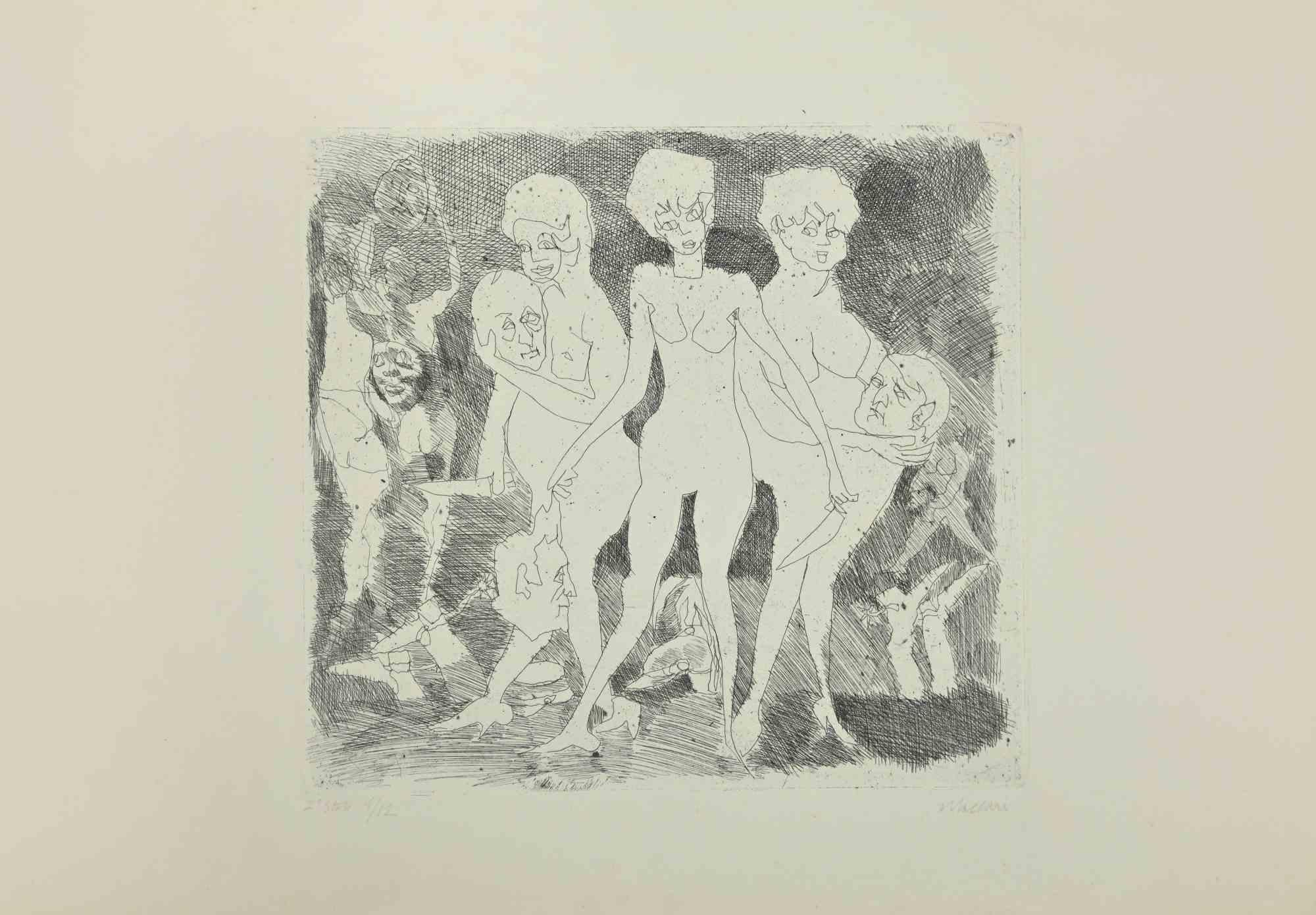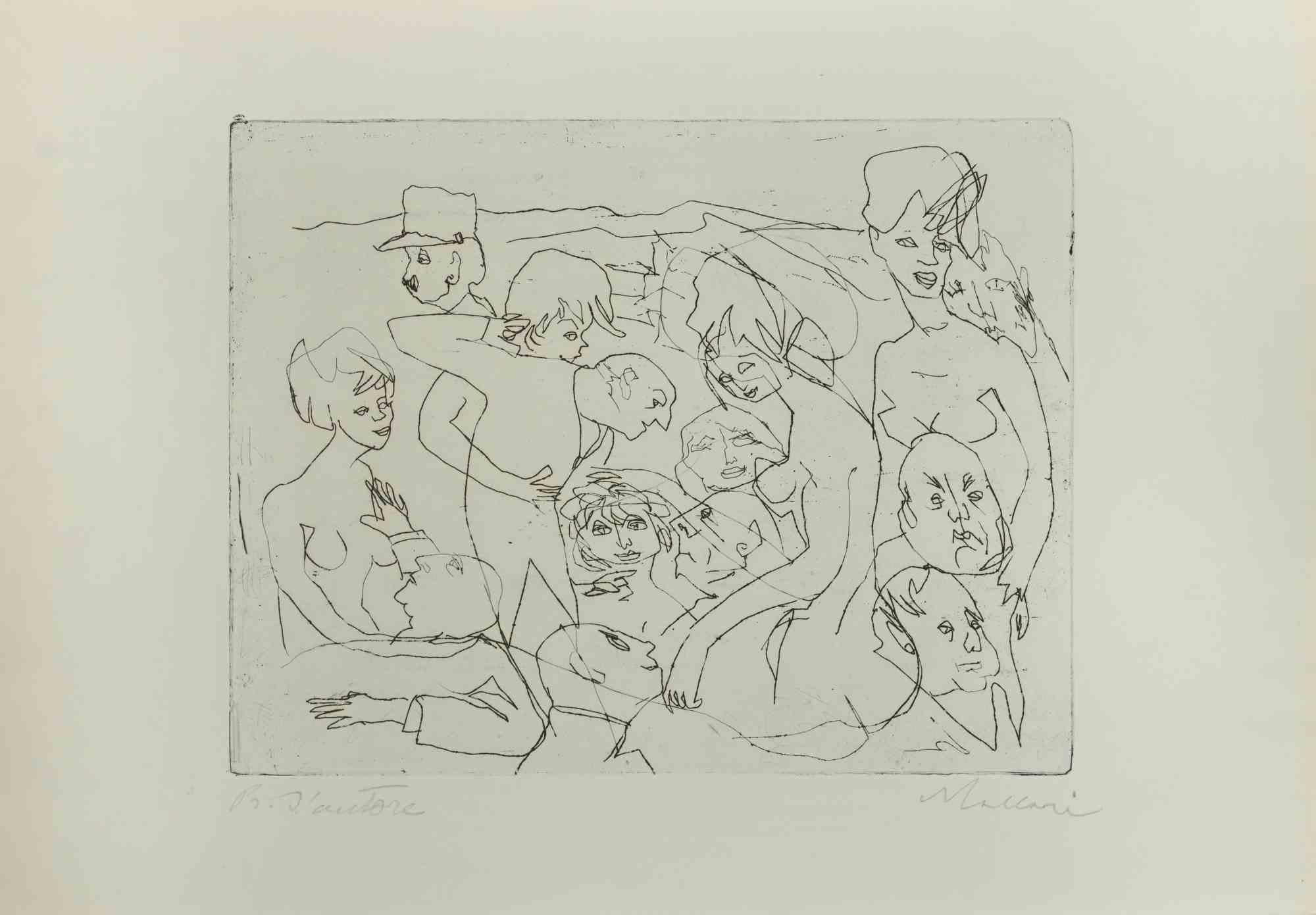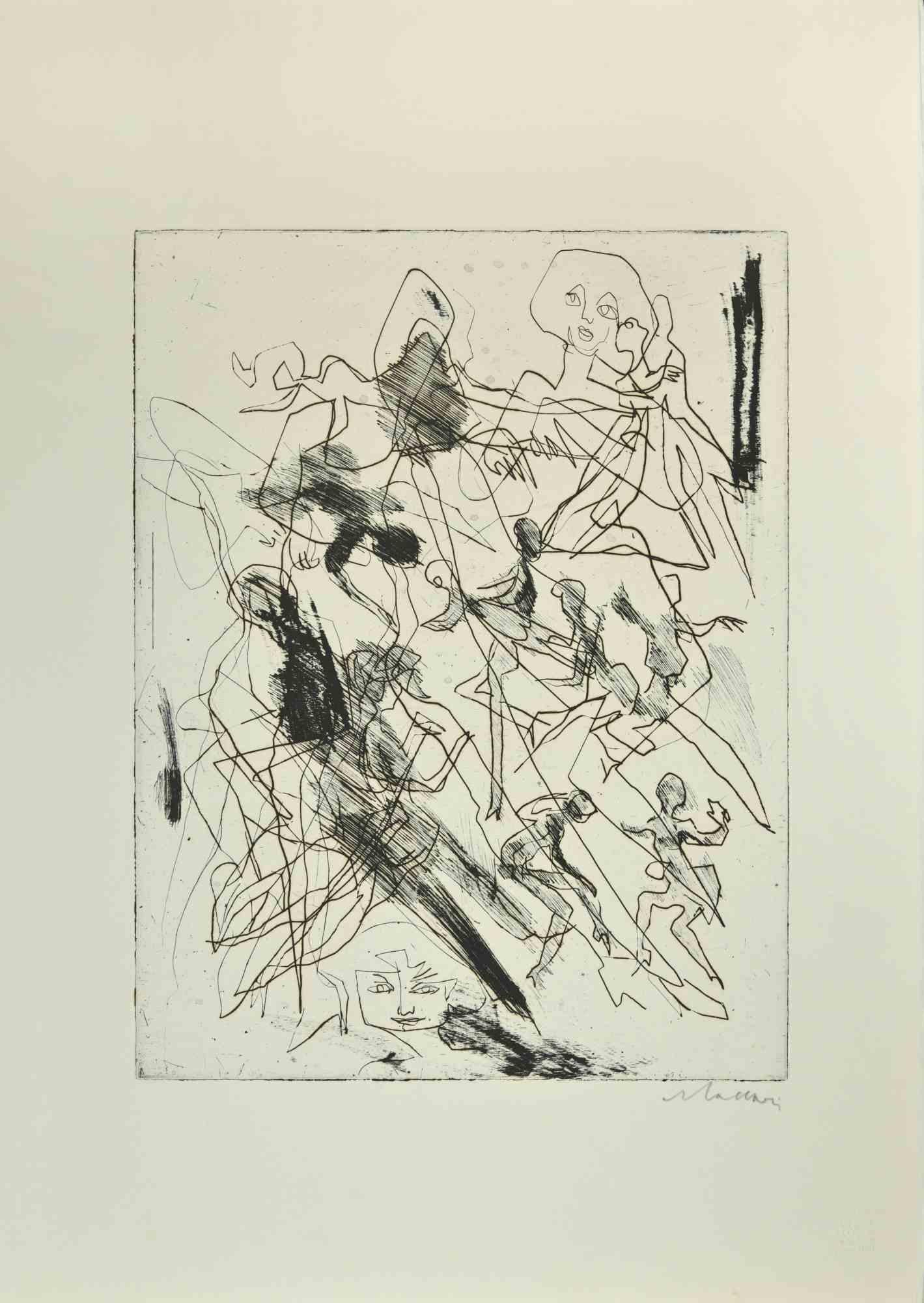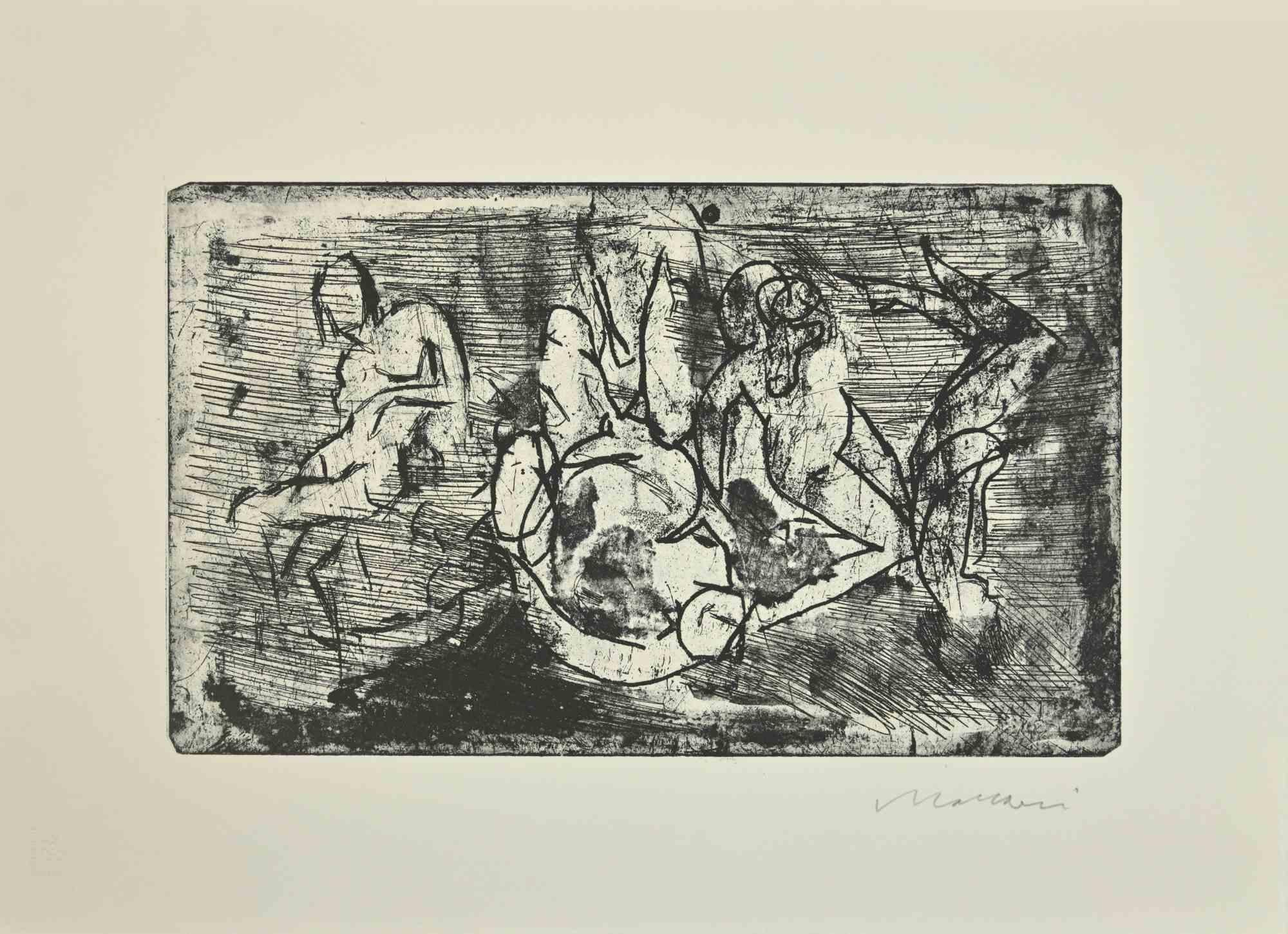Items Similar to The Souls of the Righteous
Want more images or videos?
Request additional images or videos from the seller
1 of 2
Robert Smith ForrestThe Souls of the Righteousc.1927
c.1927
About the Item
Etching, signed bottom right
Image size: 2 1/2 x 9 3/4 inches (6.5 x 35 cm)
Mounted
This is an original print from a copper plate etching by Robert Smith Forrest. It depicts one of the two longer panels of the bronze sculpture created in 1927 by Alice Meredith Williams for the Shrine of the National Scottish War Memorial, which is in Edinburgh Castle.
Meredith Williams (1877-1934) was, by the time the War Memorial was at last built after much debate, one of the most celebrated monumental sculptors of her time. Her work on the friezes was a collaboration with her husband Morris, who had served in France during the First World War and had created the drawing for the frieze, some of them from life. The final work of the frieze, in five panels, commemorates sixty roles played by men and women (not forgetting horses, mules, dogs and pigeons) during the war. Above the various panel is inscribed the phrase 'The Souls of the Righteous are in the hands of God. There shall no evil happy to them. They are in Peace'.
It is assumed that this etching was created at the same time as the bronzes c.1927. The procession seen here (along with the other soldiers depicted in the original bronzes) reputedly include at least one representative of every rank and unit serving in the First World War and of every weapon and piece of equipment employed. It is remarkable in design and execution, for in spite of all the detail which ranges from uniforms and personal equipment to horses and mules, the composition works brilliantly as a unified whole.
- Creator:Robert Smith Forrest (1871 - 1943, British)
- Creation Year:c.1927
- Dimensions:Height: 2.5 in (6.35 cm)Width: 9.75 in (24.77 cm)
- More Editions & Sizes:1 of 2Price: $314
- Medium:
- Movement & Style:
- Period:
- Condition:
- Gallery Location:London, GB
- Reference Number:1stDibs: LU52411377272
About the Seller
5.0
Gold Seller
These expertly vetted sellers are highly rated and consistently exceed customer expectations.
Established in 2007
1stDibs seller since 2014
66 sales on 1stDibs
Typical response time: 4 hours
- ShippingRetrieving quote...Ships From: London, United Kingdom
- Return PolicyA return for this item may be initiated within 14 days of delivery.
More From This SellerView All
- Colliery Scene, Lancashire, 20th Century British Artist, Wood EngravingLocated in London, GBWood Engraving on paper, signed and entitled below artwork Image size: 6 1/4 x 4 1/2 inches (16 x 11.5 cm) Mounted and framed This print depicts a scene of a colliery, that is of a ...Category
20th Century Modern Figurative Prints
MaterialsEngraving
- The Bathers, Woodcut on paper, Signed and dated 1912, Italian ArtistLocated in London, GBWoodcut on paper, signed and dated '1912' bottom right Image size: 5 x 5 1/4 (12.75 x 13.5 cm) Mounted Here the artist's bold gouging of the material has created an evocative scene ...Category
1910s Italian School Figurative Prints
MaterialsWoodcut
- Self Portrait, Mid 20th Century, British Artist, Signed EtchingLocated in London, GBEtching, entitled bottom left and signed bottom right Image size: 5 1/4 x 7 1/2 inches (13.25 x 19 cm) Contemporary frame Holding a pen and with the bottom section of the work done ...Category
20th Century Modern Portrait Prints
MaterialsEtching
- Tug Boat on the Thames, Early 20th Century Etching Print, London LandscapeLocated in London, GBEtching on paper, signed bottom left Image size: 9 x 4 3/4 inches (22.75 x 12 cm) FramedCategory
1910s Landscape Prints
MaterialsPaper, Etching
- Fulham Broadway, 20th Century English Artist, Signed and dated 1975By Peter GardnerLocated in London, GBPeter Gardner Flourished: 1949-1979 Fulham Broadway Pastel on Paper Signed with monogram and dated 1975, lower right Image size: 6 1/2 x 10 1/2 inches Acid free mount Peter Gardn...Category
20th Century Modern Figurative Drawings and Watercolors
MaterialsPaper, Pastel
- A Triptych: The Olympic Games, Modern British Drawing, Ancient Greek, NudeBy James StroudleyLocated in London, GBGraphite on paper Image size of rectangular works: 33 x 43 inches (84 x 109 cm) Image size of arched central work: 38 1/4 x 29 inches (97 x 73.5 cm) Provenance Private Collection o...Category
1930s Modern Figurative Drawings and Watercolors
MaterialsPaper, Graphite
You May Also Like
- Comic Poems - Rare Book Illustrated by G. Cruikshank - 1830By George CruikshankLocated in Roma, ITComic Poems ("Seven illustrated books in one volume") is an original modern rare book illustrated by George Cruikshank (London, 1792 - London, 1878) in 1829/1830. Published by Johnston, London. Original First Edition. Seven books bound in one volume (Tom Thumb, The real Devil’s Walk, Monsieur Tonson, The March of intellect, The Devil’s Walk, Steamers v. Stages and The Epping Hunt). Format: in 12°. The book includes Fortyfive etchings and woodcuts. Mint conditions. George Cruikshank (London, 1792 - London, 1878) was a British caricaturist and book illustrator, praised as the "modern Hogarth" during his life. His book illustrations for his friend di lui Charles Dickens, and many other authors, reached an international audience. For Charles Dickens, Cruikshank illustrated Sketches by Boz...Category
1830s Modern More Art
MaterialsPaper, Etching, Woodcut
- Figures - Drypoint by Mino Maccari - Mid-20th CenturyBy Mino MaccariLocated in Roma, ITMid-20th Century. Hand-signed in the lower right part. Numbered. Edition 1/12. Good conditions. Mino Maccari (Siena, 1924-Rome, June 16, 1989) was an Italian writer, painter, engraver and journalist, winner of the Feltrinelli Prize for Painting in 1963 and first winner of the Forte dei Marmi Satira Prize in 1973.After completing his secondary education, he enrolls in university. An interventionist like many young people of his time, he took part in the Great War at the age of nineteen as a field artillery officer. At the end of the conflict he resumed his university studies in Siena and in 1920 he graduated in law. In 1924 he was called by Angiolo Bencini to take care of the printing of the magazine Il Selvaggio, openly uncompromising fascist, revolutionary and anti-bourgeois, where his first engravings were published. After a few years of coexistence between work at the newspaper and the law firm, at the beginning of 1926 he left the legal profession to take over the direction of Il Selvaggio which he would hold until 1942. In 1928 he was the author of the small book published by Vallecchi (Florence), Il Trastullo di Strapaese (little songs and engraved woodwinds) which collected fascist songs (the same book was seized several times from Antonio Gramsci during his detention). With the transfer of the editorial staff of the Selvaggio in 1925 from Colle di Val d'Elsa to Florence, Maccari collaborated with Ardengo Soffici, Ottone Rosai and Achille Lega. In the meantime, between 1927 and 1930, he made himself known to the general public as a painter by participating in various national exhibitions. Also in 1930 Maccari works in Turin at La Stampa as editor-in-chief and has the writer Curzio Malaparte as director. His presence in the cultural and editorial world of the fascist regime is very intense, he writes and collaborates with various magazines: Quadrivio, L'Italia Letteraria, L'Italiano and Omnibus by Leo Longanesi; then, during the war, in il Primato di Bottai and, subsequently again, in Il Mondo di Pannunzio (from the first number, in 1949), up to Documento by Federigo Valli. His graphic production is also vast, ranging from the Album of Vallecchi (1925), Il trastullo di Strapaese (1928) to Linoleum (1931). Maccari illustrated in 1934 La vecchia del Bal Bullier by Antonio Baldini and in 1942 he published the Album folder, followed by Come quando fuori Piove and Il superfluo illustrata.For his pictorial work full of evident chromatic accentuations and fast brushstrokes, the violent drawing combined with the lively stroke of the graphic sign of his engravings, he is recognized by critics as a complete artist. In 1962 he was also entrusted with the presidency of the Accademia di San Luca in Rome and managed to obtain a personal exhibition at Gallery 63 in New York. His production of drawings, watercolors, temperas, etc. is endless, sometimes in collaboration with prestigious publishing houses; it is worth mentioning, just as an excellent example, the 32 b/w and color drawings with which he illustrated Il gusto di vivere, a volume that collects writings by Giancarlo Fusco, edited by Natalia Aspesi and published by Laterza in 1985. Maccari, Sienese and great contradaiolo della Torre, painted the Palio...Category
Mid-20th Century Modern Figurative Prints
MaterialsPaper, Drypoint, Etching
- Figures - Etching by Mino Maccari - 1940sBy Mino MaccariLocated in Roma, ITFigures is an Etching realized by Mino Maccari in the 1940s. Hand-signed in the lower right part. Artist's Proof. Good conditions. Mino Maccari (Siena, ...Category
1940s Modern Figurative Prints
MaterialsPaper, Etching
- Figures - Etching by Mino Maccari - Mid-20th CenturyBy Mino MaccariLocated in Roma, ITFigures is an Etching realized by Mino Maccari in the Mid-20th Century. Hand-signed in the lower right part. Good conditions. Mino Maccari (Siena, 1924-Rome, June 16, 1989) was...Category
Mid-20th Century Modern Figurative Prints
MaterialsPaper, Etching
- Figures - Drypoint by Mino Maccari - Mid-20th CenturyBy Mino MaccariLocated in Roma, ITFigures is an Etching and Drypoint realized by Mino Maccari in the Mid-20th Century. Hand-signed in the lower right part. Good conditions. Mino Maccari (Siena, 1924-Rome, June ...Category
Mid-20th Century Modern Figurative Prints
MaterialsPaper, Drypoint, Etching
- Figures - Etching by Mino Maccari - Mid-20th CenturyBy Mino MaccariLocated in Roma, ITFigures is an Etching realized by Mino Maccari in the Mid-20th Century. Handisigned in the lower right part. Numbered. Edition 4/12. Good conditions. Mino Maccari (Siena, 1924-Rome, June 16, 1989) was an Italian writer, painter, engraver and journalist, winner of the Feltrinelli Prize for Painting in 1963 and first winner of the Forte dei Marmi Satira Prize in 1973.After completing his secondary education, he enrolls in university. An interventionist like many young people of his time, he took part in the Great War at the age of nineteen as a field artillery officer. At the end of the conflict he resumed his university studies in Siena and in 1920 he graduated in law. In 1924 he was called by Angiolo Bencini to take care of the printing of the magazine Il Selvaggio, openly uncompromising fascist, revolutionary and anti-bourgeois, where his first engravings were published. After a few years of coexistence between work at the newspaper and the law firm, at the beginning of 1926 he left the legal profession to take over the direction of Il Selvaggio which he would hold until 1942. In 1928 he was the author of the small book published by Vallecchi (Florence), Il Trastullo di Strapaese (little songs and engraved woodwinds) which collected fascist songs (the same book was seized several times from Antonio Gramsci during his detention). With the transfer of the editorial staff of the Selvaggio in 1925 from Colle di Val d'Elsa to Florence, Maccari collaborated with Ardengo Soffici, Ottone Rosai and Achille Lega. In the meantime, between 1927 and 1930, he made himself known to the general public as a painter by participating in various national exhibitions. Also in 1930 Maccari works in Turin at La Stampa as editor-in-chief and has the writer Curzio Malaparte as director. His presence in the cultural and editorial world of the fascist regime is very intense, he writes and collaborates with various magazines: Quadrivio, L'Italia Letteraria, L'Italiano and Omnibus by Leo Longanesi; then, during the war, in il Primato di Bottai and, subsequently again, in Il Mondo di Pannunzio (from the first number, in 1949), up to Documento by Federigo Valli. His graphic production is also vast, ranging from the Album of Vallecchi (1925), Il trastullo di Strapaese (1928) to Linoleum (1931). Maccari illustrated in 1934 La vecchia del Bal Bullier by Antonio Baldini and in 1942 he published the Album folder, followed by Come quando fuori Piove and Il superfluo illustrata.For his pictorial work full of evident chromatic accentuations and fast brushstrokes, the violent drawing combined with the lively stroke of the graphic sign of his engravings, he is recognized by critics as a complete artist. In 1962 he was also entrusted with the presidency of the Accademia di San Luca in Rome and managed to obtain a personal exhibition at Gallery 63 in New York. His production of drawings, watercolors, temperas, etc. is endless, sometimes in collaboration with prestigious publishing houses; it is worth mentioning, just as an excellent example, the 32 b/w and color drawings with which he illustrated Il gusto di vivere, a volume that collects writings by Giancarlo Fusco, edited by Natalia Aspesi and published by Laterza in 1985. Maccari, Sienese and great contradaiolo della Torre, painted the Palio...Category
Mid-20th Century Modern Figurative Prints
MaterialsPaper, Etching





